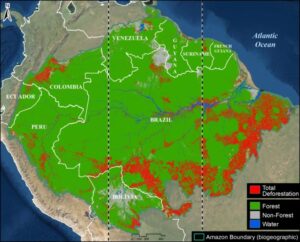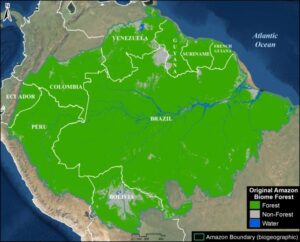MAAP #164 Tipping Point
October 3, 2022

It is increasingly reported that the largest rainforest in the world, the Amazon, is rapidly approaching a tipping point.
As repeatedly highlighted by the late Tom Lovejoy (see Acknowledgements in full report), this tipping point is where parts of the rainforest will convert into drier ecosystems due to disrupted precipitation patterns and more intense dry seasons, both exacerbated by deforestation.
The Amazon generates much of its own rainfall by recycling water as air passes from its major source in the Atlantic Ocean. Thus, high deforestation in the eastern Amazon may lead to downwind impacts in the central and western Amazon (see Background section in full report).
The scientific literature indicates this tipping point could be triggered at 25% Amazon forest loss, in conjunction with climate change impacts.
The literature, however, is less clear on the critical first part of the tipping point equation: how much of the Amazon has already been lost?
There are numerous estimates, including 14% forest loss cited in the recent Science Panel for the Amazon report, but we did not find any actual definitive studies specifically addressing this question.
Here, we directly tackle this key question of how much of the original Amazon has been lost to date.
First, we present the first known rigorous estimate of original Amazon biome forest prior to European colonization: over 647 million hectares (1.6 billion acres; see Image 1 below).
Second, we estimate the accumulated total Amazon forest loss, from the original estimate to the present: over 85 million hectares (211 million acres; see Base Map in full report).
Combining these two results, we estimate that 13% of the original Amazon biome forest has been lost.
More importantly, however, focusing on just the eastern third of the Amazon biome, we estimate that 31% of the original forest has been lost, above the speculated tipping point threshold. This finding is critical because the tipping point will likely be triggered in the eastern Amazon, as it is closest to the oceanic source of the water that then flows to the central and western Amazon.
Original Amazon Forest
Image 1 shows the first known estimate of original Amazon forest prior to European colonization. Note that we use a broader biogeographical definition of the Amazon that covers nine countries (the Amazon biome) rather than the strict Amazon watershed.

This represents the most rigorous effort to date to recreate the original Amazon. For example, we attempted to recreate original forest lost to historic dam reservoirs.
The map has just three classes: Original Amazon forest, Original non-forest (such as natural savannah), and Water.
We found that the original Amazon forest covered over 647 million hectares (647,607,020 ha). This is equivalent to 1.6 billion acres.
Of this total, 61.4% occurred in Brazil, followed by Peru (12%), Colombia (7%), Venezuela (6%), and Bolivia (5%). The remaining four countries (Ecuador, Guyana, Suriname, and French Guiana) make up the final 8%.
Comparing today’s map of forest loss with the extensive recreation of the original Amazon biome paints an impactful picture of the history and current trajectory of deforestation on a grand scale.
Follow the link below to read the full report.

